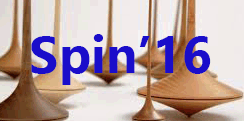Conveners
Future: Parallel IV
- Charles Hyde (Old Dominion University)
Future: Parallel V
- Alexander Kiselev (BNL)
Description
Future Facilities and Experiments
In light of the recent recommendation by the Nuclear Science Advisory committee to construct a U.S. based Electron Ion Collider (EIC), the spin community at the Relativistic Heavy Ion Collider has developed a program of must-do experiments to be run during the period leading up to the turn on of the EIC. These experiments will utilize the unique capabilities of the world’s only polarized...
In a few short years, the Relativistic Heavy Ion Collider (RHIC) will embark on detailed studies of the Quark Gluon Plasma with a major new jet-optimized detector known as sPHENIX. On the same timescale, the recent RHIC Cold QCD plan outlines a compelling program of key measurements in spin-polarized p+p and p+A collisions that can be realized on the road to an Electron Ion Collider (EIC). To...
The 2015 Nuclear Physics Long Range Plan has endorsed the realization of an electron-ion collider as the next large construction project in the US after FRIB. The machine is planned to be high luminosity, exceeding 10^33 cm−2 s−1, with highly polarized electron and proton/light ion beams, wide kinematic reach and ability to collide a variety of hadron species from p to Pb. The facility and...
Measurements of asymmetries in the inclusive and exclusive production of Lepton pairs (DY pairs) in collisions of non- polarized, longitudinally and transversally polarized proton and deuteron beams are suggested to be performed at the NICA collider of the JINR using the specialized Spin Physics Detector. These measurements can provide an access to all leading twist collinear and TMD PDFs of...
There have been many efforts to access the transverse momentum dependent parton distributions (TMDs) by using the semi-inclusive deep inelastic scatterings (SIDIS) processes. The next generation SIDIS experiments with the proposed Solenoidal Large Intensity Device (SoLID) in Hall A at Jefferson Lab, will fully utilize the great physics potential of the 12-GeV energy upgrade by combining high...
We will discuss the new E1039 experiment at Fermilab to measure the single spin asymmetry of the Drell-Yan process on a transversely polarized target. This measurement can be used to determine the sign and magnitude of the Sivers asymmetry. A non-vanishing Sivers asymmetry requires a non-zero orbital angular momentum contribution of the sea quarks to the nucleon spin. This will be the first...
We study the transverse single-spin asymmetry with a sin ϕS modulation in semi-inclusive deep inelastic scattering after the transverse momentum of the final state hadron is integrated out. In particular, we consider the case in which the transverse momentum of the final state hadron is integrated out. Thus, the asymmetry is merely contributed by the coupling of the transversity distribution...
A high luminosity polarized electron ion collider offers an unprecedented probe of the QCD dynamics of hadron and nuclear structure. I will present the JLEIC accelerator, interaction region, and detector design in the context of its impact on spin physics. The ion beams will include longitudinally and transversely polarized protons and 3He, as well as both vector and tensor polarized...
